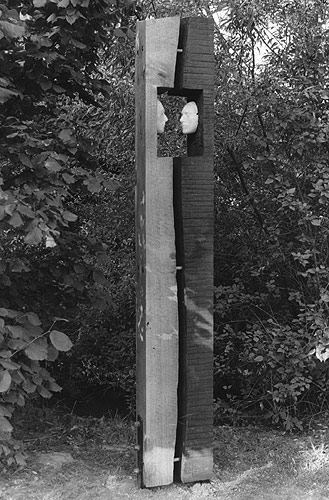
| HOME |
| NERVE |
| REVIEWS |
| ARCHIVE |
| EVENTS |
| LINKS |
| ABOUT US |
| CONTRIBUTORS |
| BACK ISSUES |
| CONTACT US |
Back to index of Nerve 12 - Summer 2008
 Hannah
Jelinek: Migration and the Artist
Hannah
Jelinek: Migration and the Artist
By Val Walsh
Hannah Jelinek came to Liverpool from the Czech Republic in 2006. The circumstances which precipitated her migration to the UK were political: she didn’t agree with Czech politics; ‘corruption was horrible’; she had loads of problems with politicians in the city of Libertz, where she lived; and she provoked a public dispute with an important city judge over her house, resulting in Hannah being legally deprived of her home.
As a result, she arrived with a single suitcase and her two daughters (now aged 17 and 7).
‘You have to have friends to come to such a controversial and crazy city as Liverpool!’ Those early friends who put her up for free in their recording studio were musicians, some English, some Czech. This hospitality was compromised by the presence of ‘loads of drugs’, which frightened Hannah and made it difficult for her children to be there. She spent four months in a squat, then found a job cleaning at a primary school, which enabled her to move to her current flat. At the start her lack of English was a barrier, compounding a feeling of isolation. She said people in Liverpool have been helpful and nice to her. ‘Different from the Czech Republic. This is a more free society.’
Hannah explained how her family had been a mixture of loving sport and loving art, so making art began for her as a child. Her mother was a painter and Director of a state gallery, as well as a World Champion sportswoman. Hannah later became a World Champion herself. Her father, who was an industrial chemist by profession, made collages in his spare time. Her grandfather was a sculptor who lived in Austria, and this location protected him: he was the only surviving grandparent from the war. The rest of her relatives of that generation lost their lives in the concentration camps as a result of the policy of Jewish extermination in the country at the time. Hannah has some of their photos on her living room wall.
When Hannah was ten (1981) her parents were sent to prison. Her father’s job as production manager for an East Czech chemical factory producing SEMTEX (possibly the most notorious and lethal of explosive materials) made him both powerful and vulnerable. His position was very risky once it was discovered his father was living in Austria, a capitalist country. Because he was so important (he knew the recipe, the production process), the government could not just sack him, they had to lock him up.
Hannah attended the Arts Academy in Prague, but it was so politically controlled, there was no inspiration from teachers, just certain craft skills to acquire. She quickly realised sculpture was her thing. ‘I love wood most of all, because it’s a living material. You have to respect it. It takes you by surprise, and I have to change my original idea. It’s also the smell I love!’
Hannah works with other traditional sculptural materials, as well as newer materials, such as cement, to produce mainly large scale work of great power and eloquence.
In the Czech Republic artists work as designers to survive creatively and to pay their bills; ‘because of this, public artists are considered to be the best artists’. Hannah worked as a public artist in streets, parks, cemeteries, playgrounds. She has not yet been involved in any projects here.
Hannah admires ‘the freedom of ideas between different styles, age groups, ethnic groups here. She applauds the fact that people have a general overview of cultures of the world and appreciates ‘the non-conformist approach to life in Liverpool’, that it’s ‘non-strict’. ‘In the rest of Europe it’s burdened with rules.’ She finds in this a certain similarity to her own life.
She is conscious of the sense of burgeoning creativity and confidence now.
She likes the way exhibitions are presented here: open to many, accessible and varied (big and small). She has never seen exhibitions as well organised and presented. Her own dream is to one day open her own gallery, focussing on original materials and objects, not reproductions.
Hannah does feel part of Liverpool, though she hasn’t yet come across a community with which she can identify. When I asked about the relationship between her identity as a woman and as an artist, she roared with laughter (she did this throughout our session) and replied, ‘All my life I was considered as a man – very tough, no compromise. Always I was forced to fight for something. Here I feel more feminine. It’s more balanced here.’
‘Sculpture in the Czech Republic is historically considered “man’s work”. Here there are no such problems: the tolerance is higher’. She speculates on losing her identity as an artist as a result of all this freedom!
‘My strongest inspiration was rebellion against something. In Liverpool it will be worse, significantly worse, because here there’s much more freedom. I don’t feel a reason to fight.’
Hannah thinks there is better education for children, with a higher level of knowledge, in the Czech Republic; but there is also weaker social stability. In general, women are more equal here than in Central or Eastern Europe. Hiring a babysitter makes you ‘a bad mother’; ‘here it is normal’! But she feels sorry for women who do not have time to spend with their children, and the consequences for teenagers. More than anything, she sees the high level of drug use/abuse as a major problem in Liverpool and worries about how to ‘give my children basic rules about life and so avoid these traps’.
Printer friendly page